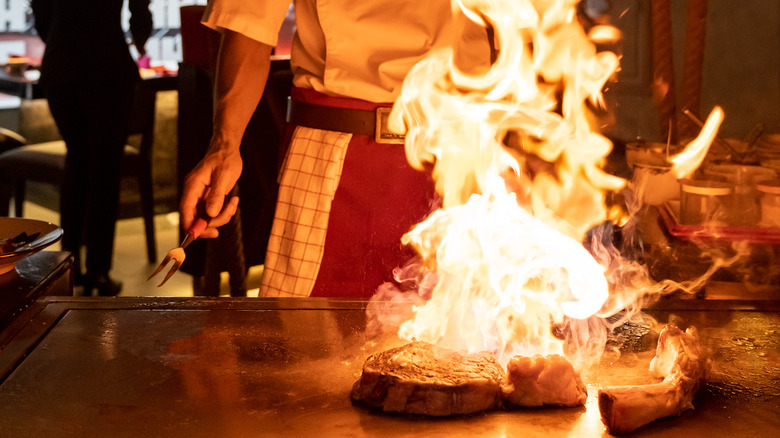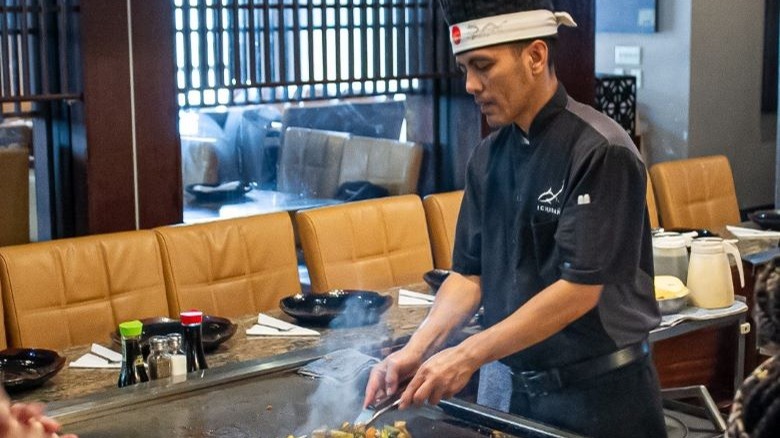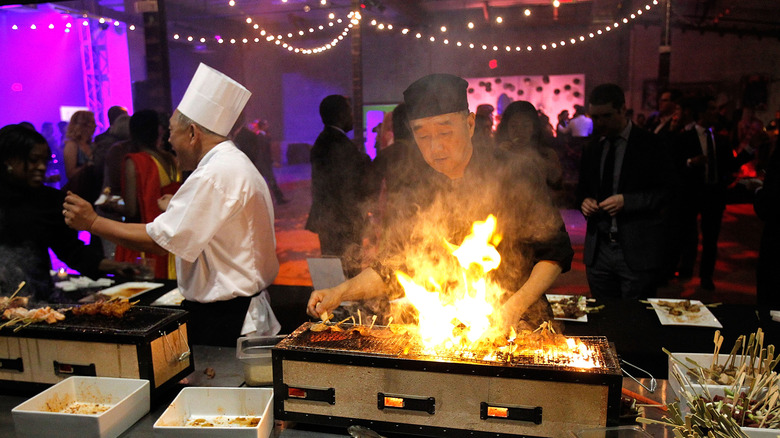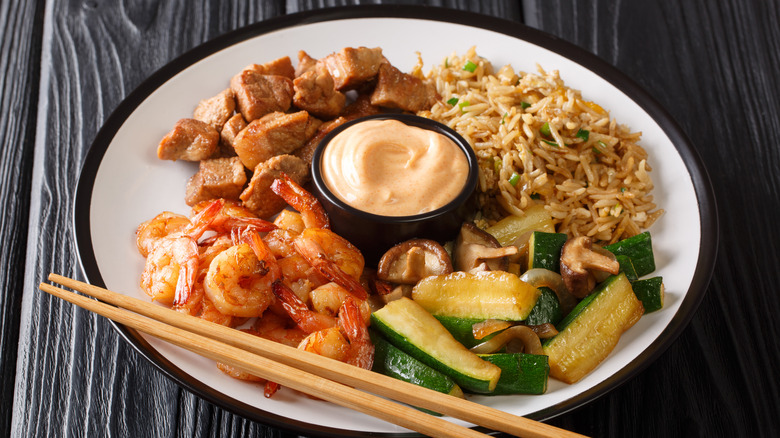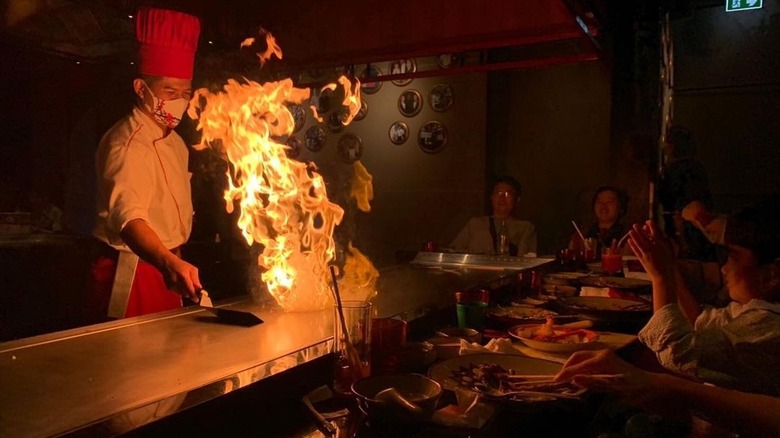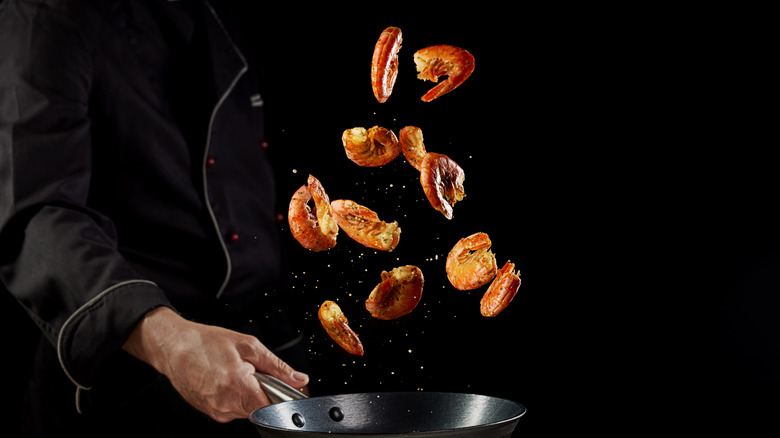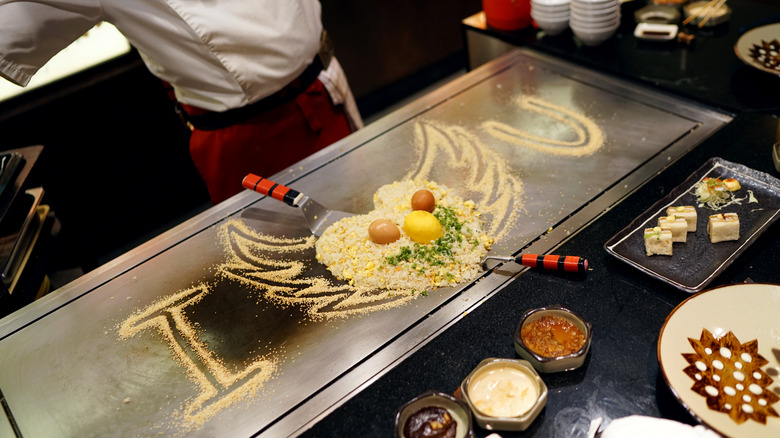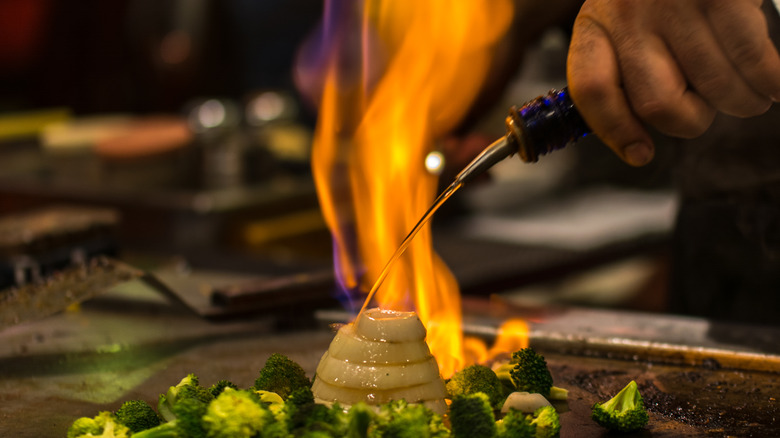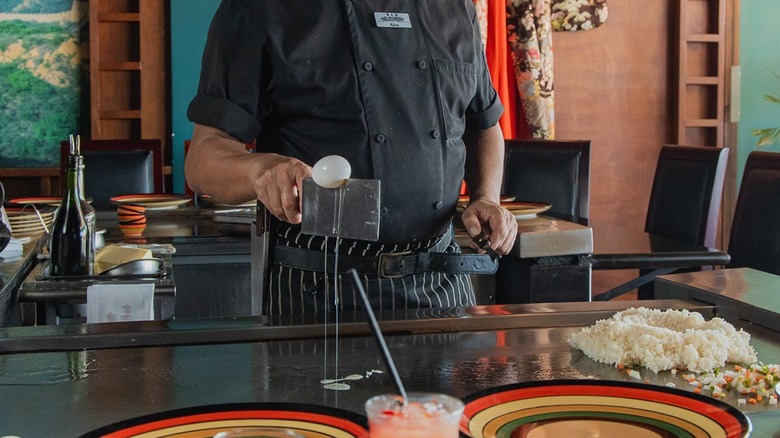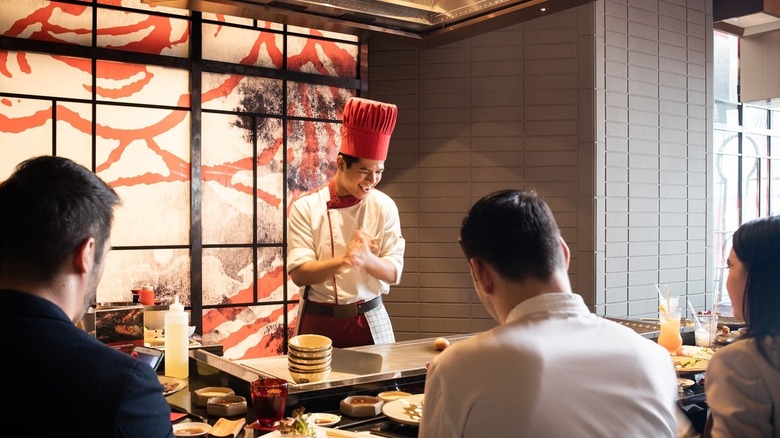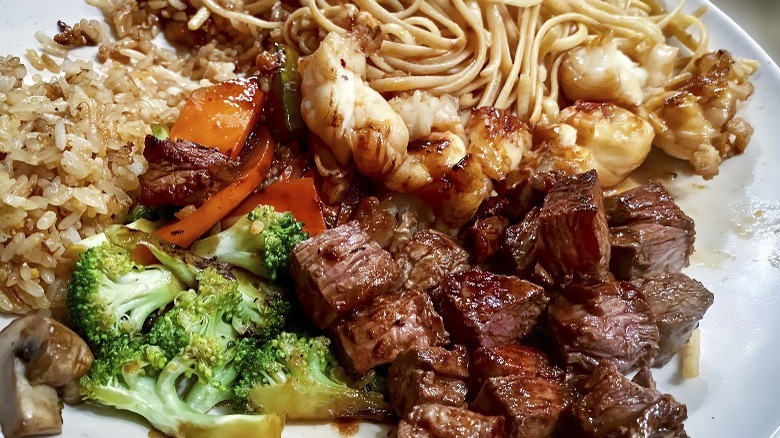A Beginner's Guide To Eating At A Hibachi Restaurant
People love dining out at hibachi restaurants because it's not just about the food. The talented chefs who work at these eateries put on exciting, entertaining shows that turn the meals into interactive, memorable experiences. Walking into one for the first time can seem confusing or even intimidating because the dining areas look different, and the noise level can be high. The menus are often long and broken up into different sections, too, so figuring out how to order the first few times can be challenging.
Hibachi restaurants were made popular in the U.S. by Benihana, modeled after traditional Japanese teppanyaki cooking eateries that used gas-heated hotplates built into tables. Hibachi-style restaurants have electric grills, while traditional teppanyaki ones work with propane tanks. The grill surfaces are designed to cook meat, pork, poultry, and seafood. They're also used to prepare vegetables, eggs, and tons of rice.
Knowing what to expect can help you make the most of a hibachi restaurant meal. And besides that, if the chef notices that it's your first time, you might be spotlighted in the performance. Some people love being the center of attention, but others are more reserved.
What is a hibachi restaurant?
Hibachi restaurants generally have several grills that are each integrated into separate seating areas. The seats and countertop surround three sides of the grill, with the chef at one end. Since the oil on the hibachi grills doesn't drip into burner elements, there is fire but no smoke going into a patron's eyes or throat.
The grill areas can seat around 15 people, so unless you're going with a large group, you'll probably be sitting with strangers. Leaving an empty seat in between is fine if there's room, but otherwise, you'll be rubbing elbows. You can't predict your neighbor's personality, but there's usually a spirit of fun and camaraderie at the tables.
The chef will arrive at the table once everyone is seated, and servers will introduce themselves and start taking orders. Then, the chef makes an introduction and starts the preparations. The order for the whole table is taken at once unless more people show up before the cooking starts.
The hibachi-cooked food is served around the whole table as it's grilled, but salads, soups, and other items are brought by the servers. The food prices aren't low, but usually not as high as upscale steakhouses or seafood restaurants.
The decor is traditional
Hibachi restaurant owners don't go all-out on the decor since patrons spend the majority of their time watching the chefs. Look for dim, delicate lighting and minimalistic, traditional Japanese designs. There will be a lot of natural colors and materials, like brown wood floors, black-and-white marble, ebony bar counters, and perhaps some red-cushioned chairs. Some have pretty bonsai trees, rock gardens, and water features, too.
The hibachi grill areas will take up most of the space, but there could also be a separate area with individual tables and a bar. Many of these restaurants are byo, but others have full bars, so if yours has one, consider sampling the sake.
The kitchen is often separate from the grill area and may be visible or in another area. There might also be Japanese wall hangings and soft music playing. This all creates a serene backdrop for lively mealtimes. These restaurants also tend to have quiet, large bathrooms where you can go to take a break from the fun.
Hibachi chefs are like comedians
Hibachi chefs have rolling trays that hold all their ingredients, and if you sit close enough, you'll see it. They greet everyone at the beginning of the meal and usually squirt some oil onto the grill. This flaming introduction is a real ice-breaker that captivates audiences from the start.
Most of these talented chefs learn the craft on-the-job starting out as line cooks, while others are culinary school graduates. The key to success is hibachi cooking skills, of course, but charisma and personality are just as important. The best hibachi chefs engage customers, making them smile and laugh with delight. There's no snootiness here — these chefs make jokes, perform clever tricks, and are often the center of their own jokes.
They usually start with a few spatula flips or juggles and sometimes pull out hidden ones from behind audience members' ears. They can pick out beginners in seconds and often have them take part in the performance. This might involve squirting sake in a diner's mouth, tossing in a piece of shrimp, or making funny faces. More experienced customers are also chosen and are thrilled at the attention, but newcomers like it too.
What's on the menu
Although every Hibachi restaurant has its own menu, there are common foods that can be seen in most of them. Under appetizers, you might find egg rolls, edamame, Japanese dumplings, and chicken wings. The menu might also offer sushi, sashimi, teriyaki entrées, noodle dishes, soups, salads, and desserts.
These items are paired with fried rice and different grilled vegetables like onions, peppers, broccoli, and carrots. All of this tastes so delicious once it's cooked because the chefs use copious amounts of butter, oil, or both. The most common kinds of flavor enhancers are soybean oil, garlic, sesame oil, soy sauce, mirin, and ginger dipping sauce.
Hibachi entrées typically come with soup and salad. A small miso soup is often served first that has a fermented soybean paste base. The soup might also contain vegetables, tofu, and seaweed. The salad is also pretty basic, often with lettuce, maybe a few other vegetables, and a thick, slightly tangy ginger dressing. And depending on the restaurant, there might also be desserts and a full bar.
How to behave at Hibachi restaurants
A hibachi restaurant might have chefs who take the orders, servers who handle them, or a combination of both. Your server might take your appetizer and drink order, but oftentimes, patrons give their hibachi entrée orders to the chef. Patience is important, especially when there are a lot of people sitting around the grill.
The chef often grills a first course of chopped shrimp and serves it to everyone before beginning the entrée. Then, as each part is cooked, the chef pushes it to the side of the grill and continues. Your order could be cooked first, last, or in the middle, but it won't be plated and served until everyone's is finished. The chef will serve the food, so you don't have to worry about fixing a plate for yourself.
The chef will set the tone for the table, and while some are boisterous and even silly, others are not as interactive with the crowds. Either way, the chef deserves to be respected and shouldn't be distracted while actively cooking unless they take the lead. Feel free to ask questions and show encouragement by clapping and laughing at the performance when appropriate. Hibachi chefs will indicate if they have chosen you for a sake squirt or shrimp toss, but if you'd prefer not to, you can just say so politely.
All about flying shrimp and squirting sake
That shrimp appetizer is a tasty part of the show, and patrons love to show off their skills. It's called the shrimp feed or shrimp flip. Here's how it works, the chef cooks up a bunch of shrimp on the grill with a spatula and then puts a small piece on it. They indicate a recipient and toss the shrimp toward that person's mouth, sometimes it hits the mark, and sometimes it doesn't.
Some hibachi chefs and customers are much better at this than others, and this is all part of the fun. Imagine how proud a young child might be after a perfect mouth catch and how silly someone else might feel when they miss it. You have to be a good sport to play this game, and sometimes, the chef will try a few times before a catch is made.
These chefs have better aim with sake squirts because there's more control. Also hilarious, this involves the chef holding a squeeze bottle of sake and squirting it into a customer's mouth. And if you haven't been chosen and want to participate, just get their attention by raising your hand.
You'll fall in love with the rice
Hibachi grills handle huge piles of fried, brown, and steamed rice, and the chefs are constantly moving it around with their shiny spatulas. Some do the heart-shaped rice trick, where they form it into the time-honored symbol of love while it's frying. This is probably the easiest trick in their routines and is pretty impressive.
Hibachi fried rice is made with different kinds of oil, soy sauce, rice cooking wine, garlic, and plenty of salt. Some restaurants make it with shichimi togarashi, a 7-spice Japanese seasoning. Chefs also crack eggs onto it in the traditional fried rice fashion and might also add green peas, onions, and other minced veggies. Don't be shy about asking for less oil or salt or one of the different kinds of rice, but do so when placing your order and not after the chef has started cooking.
An onion will burst into flames
Your hibachi chef might kick off the presentation by squirting oil onto the grill to make flames shoot up — sometimes, they also do this throughout the cooking for added drama. But that's not the only fire trick that they do. Everyone enjoys the hibachi volcano onion trick when the chef forms a small pile of onion rings into a volcano shape and lights up the middle. The flames shoot out from the center, and it's pretty awesome to see.
How does the center part ignite? Most of the time, the chef squirts a bit of alcohol and cooking oil into the middle and uses a long-handled lighter to set it off. The flame goes out in less than a minute, and it's usually only performed once during the show. Do not try this one at home because even though it might look easy, it's not hard to get burned while doing it.
You'll witness another kind of egg roll
Hibachi restaurants might serve fried egg rolls, but the clever chefs do another kind of egg roll at their grills. Benihana chefs are known to do it, but it requires finesse and not every hibachi chef in the world has mastered it. The trick is to place an egg on the spatula, launch it into the air, and turn the spatula to the side. When the egg descends, it makes contact with the edge, cracks, and the insides drop onto the grill.
The chefs also roll the egg back and forth along the flat spatula or flip it up and down while their guests follow it with their eyes, waiting for it to fall. Others are talented enough to make the shelled eggs stand vertically on top of the grill! It's important to mention here that hibachi chefs aren't perfect — they frequently drop eggs, miss mouths, and lose spatulas. It's all part of the show, and when they mess up, everyone has a good laugh. We bet that these places go through a heck of a lot of eggs, though.
It's noisy in there
Hibachi restaurants tend to be noisy because the chefs are loud, the tools are clattering, and people are usually having lots of fun. It's common for parties to be booked at these spots, and some of the time, children are in attendance. When the location has a liquor license, expect the noise level to be taken up a few notches.
Diners enjoy cheering on the chefs, toasting to celebrations, and when things get going, it can be hard to hear the server asking for your drink order. Don't plan on having a quiet meal at a hibachi restaurant, but know that the chances of encountering fewer people at one increase on weeknights and lunch hours. However, there's a downside to this since the chef might not be as inspired without as many people egging things on. Still, a beginner can do this to become familiar with how things are done.
You don't have to order Hibachi
Diners who visit steakhouses aren't required to order steak, and the same idea applies to hibachi restaurants. Not everybody likes the featured food at restaurants, and that's why the owners offer different menu choices. Hibachi restaurants usually stick with Japanese food, but you can enjoy other food items as well — depending on the location.
In some cases, you don't need to stick to the hibachi menu's listed descriptions. It won't hurt to ask for more rice instead of onions, noodles instead of rice, or two salads instead of soup and salad. There's no guarantee that the restaurant will do this, but if they do, then you'll be pleasantly surprised. This is not considered bad manners when the customer asks before the cooking starts. Some even have make-your-own hibachi entrées, with choices of proteins, vegetables, and starches.
We don't recommend wearing your best outfit, though, because squirted sake, flying shrimp, and hot oil can leave stains. But one visit to a hibachi restaurant will teach you everything you need to know about these restaurants. Once you feel comfortable enough, you'll be laughing with the crowd and eager to try different entrées.
